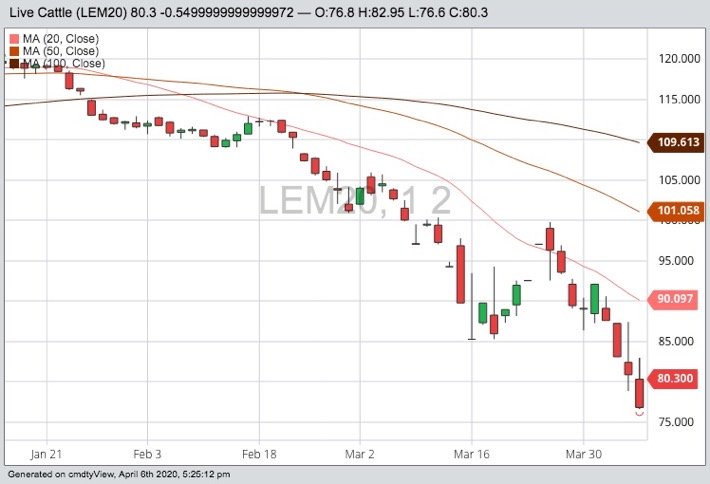Chicago | Reuters — U.S. live cattle futures plunged to their daily trading limit on Monday — with prices for the front-month contract hitting the lowest seen since December 2009 — as beef inventories remain robust with much of the U.S. restaurant industry shuttered due to the pandemic.
April live cattle were down the 4.5-cent limit at 83.825 cents/lb., while actively traded June futures finished at 79.85 cents, down one cent and the lowest for a June contract in at least 11 years (all figures US$).
Meanwhile, lean hogs and fed cattle rose on technical buying, as some investors took advantage of sharp price drops in the livestock market last week, said traders.
Read Also

Alberta crop conditions improve: report
Varied precipitation and warm temperatures were generally beneficial for crop development across Alberta during the week ended July 8, according to the latest provincial crop report released July 11.
U.S. hog futures fell on Friday to the lowest point since late 2002 on tumbling pork prices and slowing slaughter rates as measures to control the coronavirus pandemic shuttered schools and restaurants and sent U.S. unemployment rates soaring.
“Prices are getting low enough, and low prices tend to correct the market,” said Terry Reilly, a senior analyst with Futures International in Chicago. “We could see that in the livestock markets in the week to come.”
CME April lean hog futures ended up 0.9 cents at 41.125 cents/lb. Most-active June settled up 1.325 cents at 49.65 cents/lb.
May feeder cattle futures settled up 1.2 cents at 109.3 cents/;b.
Trading limits for all three commodities will remain at their expanded levels of 4.5 cents on Tuesday, the CME said.
While U.S. meat exports have grown in recent months, the loss of restaurant sales — a major buyer of beef — and school lunch program sales channels have come as a blow to the livestock and meat-packing sector, said Karl Setzer, commodity risk analyst for Agrivisor.
“We cannot consume as much meat as we’re producing, and we can only get so much out in exports,” Setzer said. “We have oversupplied this market on beef and pork — but especially on pork.”
The pandemic has already been causing supply chain havoc in the U.S.
Tyson Foods said Monday it shut an Iowa hog slaughterhouse after more than 24 cases of COVID-19 involving employees at the facility, in the latest disruption to the U.S. food supply chain from the coronavirus outbreak.
Tyson said it will divert hogs to other pork plants in an attempt to minimize the disruption from the closure this week of its slaughterhouse at Columbus Junction, about 210 km east of Des Moines.
Separately, National Beef Packing Co. said it suspended cattle slaughtering this week at a plant at Tama, Iowa, about 110 km northeast of Des Moines, for a cleaning previously scheduled for later this month.
JBS USA said separately it halted operations at a beef plant at Souderton, Penn., north of Philadelphia, and plans to restart production April 16. It reduced operations at the facility last week after senior managers suffered flu-like symptoms.
— Reporting for Reuters by P.J. Huffstutter in Chicago; additional reporting by Tom Polansek and Christopher Walljasper in Chicago.














